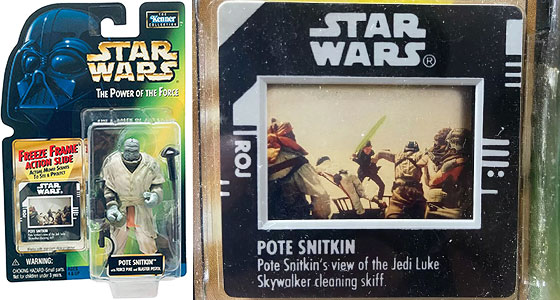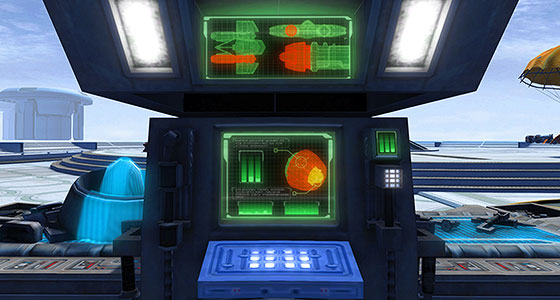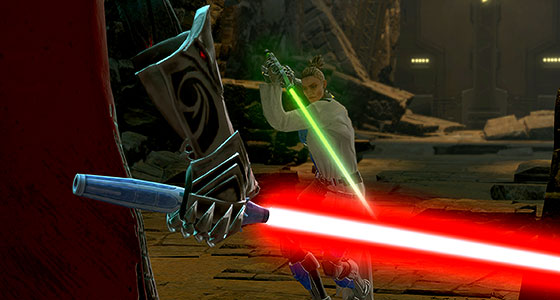While I still intend to write about the story of Star Wars the Old Republic’s Desperate Defiance update, I’d like to instead start with a look at a brand new Aurebesh sign that has ties to not only one from the earliest days of SWTOR but also to an extremely obscure bit of Star Wars lore from more than twenty five years ago.
Much of the action in Desperate Defiance takes place in a new area of Hutta called the Minboosa District. Now that I’ve visited Minboosa as part of the story and seen how the changes have also affected “regular” Hutta as well as the Karagga’s Palace operation, I want to take a moment to appreciate how impressive the updated Hutta looks. The old yellow cast to the areas was intense and alien, but now every corner of Hutta is thick with haze and smog. Being outside on Hutta feels gross; it feels like it’s going to stick to your character even when you scramble indoors, and it’ll take more than just a long sonic shower to wash it all off.
At first glance, Minboosa shares similar architecture to the town of Jiguuna on Hutta where Imperial Agents and Bounty Hunters begin their class stories. Minboosa is perhaps a bit more densely packed with buildings, but once you venture outside the town itself, you can really appreciate the changes. Soaring trees, Tibanna gas refineries and landing platforms tower overhead like skyscrapers on Coruscant. Nem’ro’s palace feels positively quaint by comparison.
The center of Minboosa is, of course, the cantina. Shining above its entrance, is a holographic neon sign. This sign is similar to the one above the cantina in Jiguuna, but there are some differences. It’s this earlier sign with which we’ll start. The neon declares that the cantina is called “The Poison Pit” and features radiating circles that act to focus our attention on the logo and the letters atop it; below the three lower letters are framed by octagons and follow the arc of circles. These design elements feature in many examples of the holographic glow that illuminates the player’s journey across the galaxy, most prominently on nearby Nar Shaddaa. The purple creature at the center is a Chemilizard, one of Hutta’s native species that evolved to survive off the pollution that resulted from the Hutt’s short-sighted mistreatment of the planet.
The writing used in this sign is not technically Aurebesh, rather it is a variant known most commonly as “Galactic Standard.” I’ve written about the different types of Aurebesh before, but in general I imagine these alphabets are at least legible and perhaps interchangeable to most of the characters in the game world.
The neon sign above the cantina in the Minboosa District shares a similar design to the Poison Pit sign. This difference that jumped out at me immediately is that this graphic employs a “traditional” Aurebesh font familiar to anyone who’s encountered these letters in other Star Wars media or even Galaxy’s Edge at Disney. While sharing a similar circular design to the previous graphic, this one places the word “skiff” in a horizontal shape which acts as a base for the central graphic which helps enhance the feeling that the speeder is floating above the ground.
I imagine it must have been an interesting design challenge to create a new neon sign for the cantina in the style of one from well over a decade ago, but the artists at Broadsword pulled it off. The two signs are similar, but different enough that they can be told apart at a glance.
However, I do want to explore the meaning of this sign. The image in the center depicts a skiff, a light, open-top repulsorlift “hover-boat” first seen during Return of the Jedi during the battle above the Great Pit of Carkoon.
The name of the cantina, the “Dirty Skiff” sparked a very specific memory for me. Throughout the history of the various Star Wars action figure lines from Kenner and later Hasbro, the toys often includes additional gimmicks: cheap collectible coins, digital bobbins with poorly recorded bits of dialogue or sound effects, and, perhaps most unusual of all, “Freeze Frame Action Slides.” These were two-inch square frames with a small, still image of a scene from one of the Star Wars movies. These images were meant to be seen through an “Action Slide Viewer” (Sold separately, of course; batteries not included, of course) a toy shaped like a pair of Macrobinoculars that allowed you to look at the slides in a manner similar to the old Viewmaster toys. The Freeze Frame Slides could also be used in a traditional slide projector, something familiar to anyone who grew up in the era before digital photography. If this all sounds weirdly retro to you now, believe me, it was nearly as silly back then.
The Freeze Frame Slide included with the “Pote Snitkin” figure, a character both obscure and ridiculously named even by Star Wars standard, features Luke Skywalker in battle during Return of the Jedi’s Sail Barge rescue with a caption that stuck with me all these years.
Some of my Star Wars friends found the phrase “cleaning skiff” to be quite amusing and imagined that it might have come to be slang in the Star Wars universe for “kicking butt.” Maybe it’s just me, but I don’t think it’s too far a leap from “Cleaning Skiff” to “Dirty Skiff” which, depending on how dirty your mind is, could have all sorts of additional meanings.
Is this holographic sign an intentional homage to an odd accessory from a twenty-five year old action figure? I can’t say for sure, but once I made the connection, I knew I had to share it. And it’s not the first time something from Star Wars toys seems to have inspired something in SWTOR.
I’ve said it before, I’ll say it again: there is so much weird, dumb, silly and wonderful lore across the history of Star Wars. None of it should be taken seriously, but it’s funny what bubbles to the surface sometimes.







































